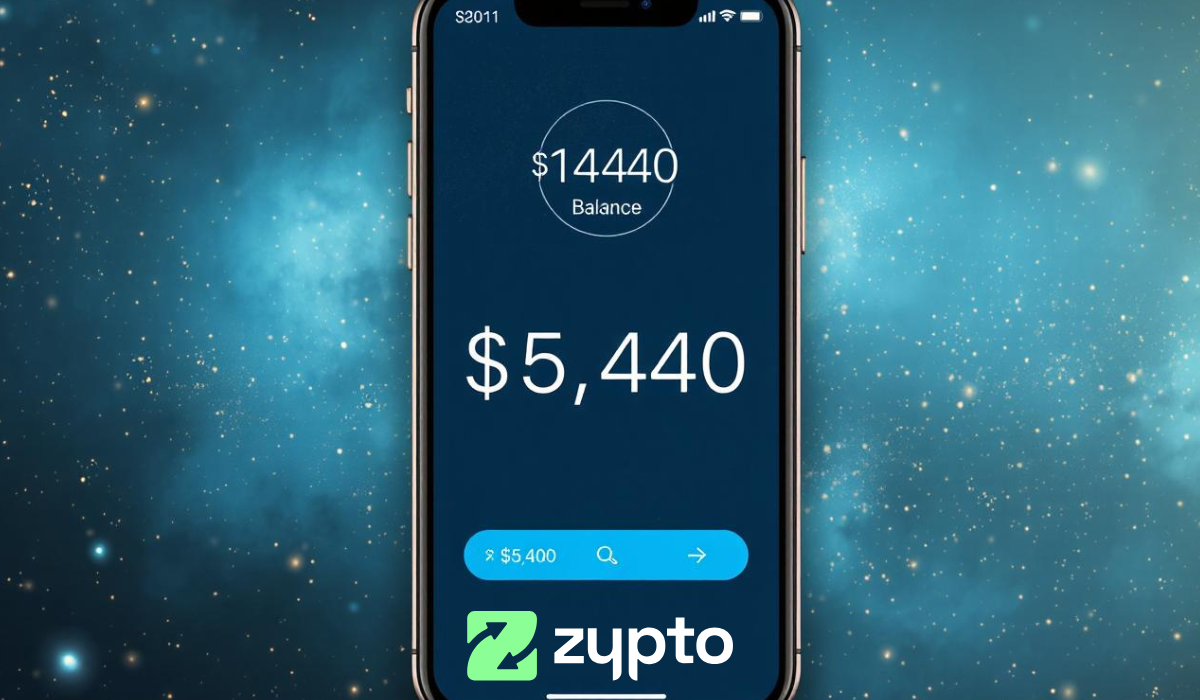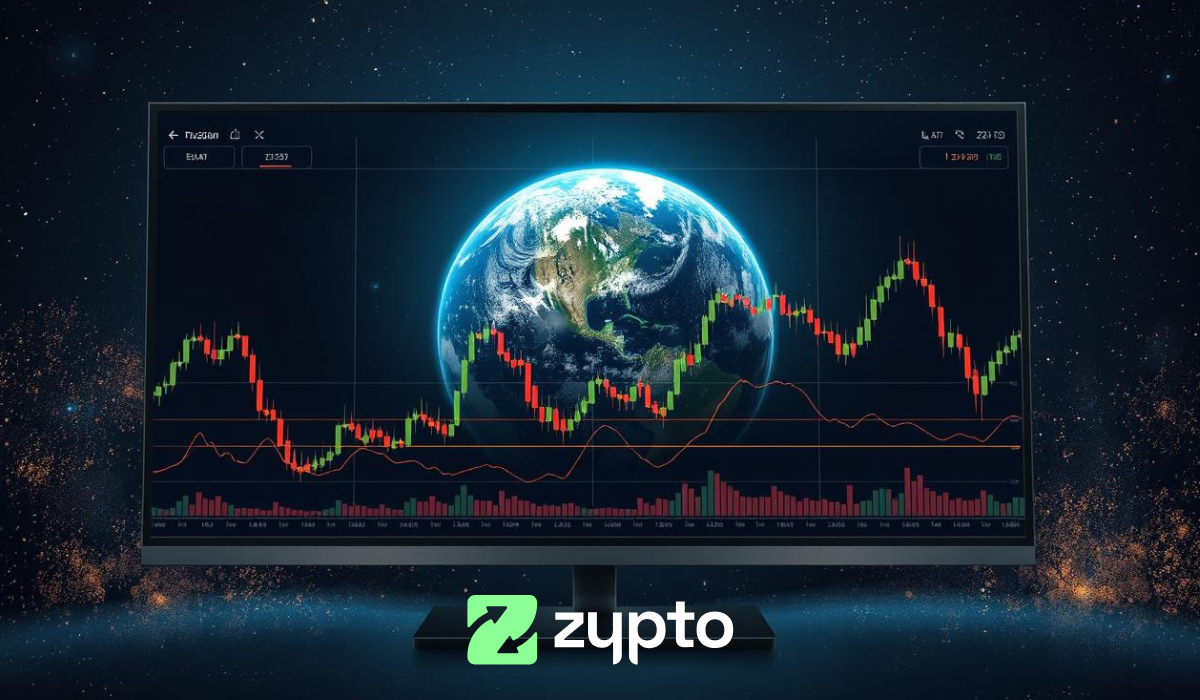In the journey of mastering the crypto-verse, the next vital knowledge after understanding cryptocurrencies and blockchain technology is an introduction to crypto trading. This covers an exposition of the crypto trading idea as well as the basic strategies and tools that facilitate effective crypto trading.
Crypto Trading
Crypto trading basically involves buying and selling coins via an exchange or speculating on the price movements of cryptocurrencies via a CFD account. Crypto trading is a world of its own, requiring lots of skills and best practices to navigate smoothly. However, with this simplified introduction to crypto trading which explains the basic strategies and tools, you’ll be better armed for the journey ahead.
What is Crypto Trading?
Crypto trading is speculating on the price movement of cryptocurrencies via a contract for difference (CFD) trading account. In other words, you’re taking a position on the price action or movement of a cryptocurrency against the dollar or another cryptocurrency. For example, if you think the price of a cryptocurrency will go up, you can go long (buy) on the trade. If you think otherwise, however, you could go short (sell). Eventually, if your prediction is correct you’d make a profit.
Crypto trading can also mean buying and selling crypto coins on an exchange. As such, whenever you buy a coin on an exchange, you’ve engaged in crypto trading since there’s an exchange of currency. Similar to traditional financial markets, crypto trading can be done on various platforms and involves different basic strategies and tools.
What Determines Cryptocurrencies Price?
Crypto traders and investors analyze certain variables to predict and respond to market movements. The interplay of these factors creates the often volatile nature of cryptocurrency prices. Before we delve into the basic strategies and tools for crypto trading, let’s see the factors that influence cryptocurrency prices.
Force of Demand and Supply
Demand for crypto coins is often influenced by factors such as investor interest, usability, and adoption. When there is a high demand and limited supply of cryptocurrency, prices go up. In terms of supply, the supply of a coin refers to the total amount of the cryptocurrency available. Cryptocurrencies with a fixed or limited supply (like Bitcoin) can see price increases as demand grows.
Market Sentiments
Market sentiments describe the market’s (traders and investors) attitude or feelings toward cryptocurrency. Positive news (such as regulatory approval or institutional adoption by major companies) can boost prices, while negative news (like security breaches or regulatory crackdowns) can drive prices down. In the same way, opinions and endorsements from influential figures or large communities can significantly impact prices.
For example, in 2021, doge’s price surged past its previous all-time high by 216%, and that’s all thanks to the renowned Tesla CEO, Elon Musk. Doge was a simple meme coin until Musk announced that Tesla would accept the coin as a means of payment for Tesla merchandise.
Market Liquidity
Liquidity plays a pivotal role in price stability. And when you say that a cryptocurrency is liquid, it means that the currency can be easily converted to cash. Coins with higher liquidity (that has a high volume of trade) tend to be less volatile, while low liquidity can cause high volatility. Being listed on major exchanges also boosts accessibility and liquidity, potentially driving up prices.
Technology Advancement and Innovations
Blockchain technology is relatively new and is improving at a rapid pace. Improvements to a cryptocurrency’s technology can increase its value. For example, the introduction of new features or applications that enhance the cryptocurrency’s utility can drive demand and price.
Regulation
Changes in laws and regulations regarding the use and trading of cryptocurrencies can significantly influence crypto market behavior. Regulatory developments in different countries can affect prices. For example, a country banning or embracing cryptocurrency can lead to significant price movements.
Economic Factors
Similar to traditional financial markets, cryptocurrencies are not immune to the effects of global economic factors. Inflation rates, currency values, and economic stability can influence investor behavior and, consequently, cryptocurrency prices. Prices of cryptocurrencies can be correlated with other markets, like stocks or commodities.

How Does Crypto Trading Work? Basic Crypto Trading Strategies
There’s a long list of trading strategies everyone that who chooses to delve into the crypto world should know. Each of these strategies has its set of advantages and risks. Successful trading often involves a combination of basic strategies and tools, as well as continuous adaptation to market conditions. Here are some basic crypto trading strategies that traders commonly use to navigate the cryptocurrency market.
Fundamental Analysis
Fundamental analysis is a process of examining an asset’s intrinsic value as well as factors that could affect future price changes. This form of analysis concerns itself with external influences, events, and industry trends. Ultimately, the purpose of fundamental analysis is to determine a cryptocurrency’s intrinsic value.
When you then compare the coin’s value to the current market price, you can determine whether the asset is undervalued or overvalued. Investors usually take advantage of an undervalued asset by purchasing it; an undervalued asset presents a profit potential. An overvalued asset can be a signal that it’s time to sell and make a profit.
Technical Analysis
Technical analysis is a universal language of the financial market. Hence, respective of the financial instruments you’re trading; Bitcoin, Ethereum, futures, forex, or stocks. Typically, you can use technical analysis to forecast the price movement of any tradable instrument that’s subject to the forces of demand and supply. Hence, if you understand the nitty-gritty of technical analysis you can use it for almost any financial instrument.
Now, what technical analysis? While the big name can throw one off-base, technical analysis is simply the act of studying the market and predicting the price movement of cryptocurrencies. By examining or analyzing the market using market statistics and price charts, crypto traders aim to arrive at a fairly accurate prediction of future price trajectory. Technical analysis assumes that past trading activities and price changes can be useful in predicting the future price movement of an asset when paired with accurate trading rules.
Technical analysis differs from fundamental analysis in that it focuses on price charts; it’s an attempt to identify the patterns on a chart as a tool to predict future price movement. It most commonly applies to price changes, but over the years, analysts have expanded its use to include tracking trading volumes and more. Although hundreds of signals and patterns have been developed by researchers for technical analysis, the most commonly used indicators and patterns include moving averages, trend lines, channels, and momentum indicators.
Dollar-cost averaging (DCA)
This is a trading strategy where you invest a fixed amount of money at regular intervals, regardless of the price. Rather than deal with the cumbersome job of timing the market you could simply make little investments at intervals and build wealth in the long term. If you prefer a less risky and systematic approach then this strategy may be for you.
Why invest this way? With dollar-cost averaging, traders try to reduce the impact of volatility by spreading out investments over time. So, let’s say you want to invest $10000 in ETH. Rather than throw in the entire money at once, you can decide to invest $200 every week irrespective of whether the currency is experiencing a downtrend or not. This means that your $10000 investment will span over 50 weeks.
Buy and Hold (HODLing)
Hodling is among the most common crypto investment strategies. Hodling is a strategy where crypto investors buy and hold onto certain assets they believe have profit potential for the long term. Instead of actively trading crypto daily you simply buy a cryptocurrency and hold onto it for a long period, regardless of short-term price fluctuations.
The objective of the buy-and-hold strategy is to profit from long-term price appreciation. It’s suitable for investors working with a long-term horizon who believe in the future growth of the cryptocurrency market.
Day Trading
Day trading taking positions and exiting on the same day. With this strategy you make multiple trades within a single day, aiming to profit from short-term price movements. It allows you to leverage intraday price volatility. However, day trading is best suited for experienced traders who can dedicate significant time to monitoring the market and executing trades quickly.
Swing Trading
In swing trading, you hold a cryptocurrency for several days or weeks to benefit from expected price swings. Traders use this approach to seize gains from medium-term price movements. However, this can only work for those who can commit to regularly monitoring the market.
Scalping
Scalping involves using increased trading volume to make a profit. In scalping you make numerous small trades throughout the day. The aim is to accumulate small trades that add up over time. Scalping is suitable for traders who prefer high-frequency trading and can act quickly on small price movements.
Momentum Trading
Traders who can identify and react to market trends use this strategy to capitalize on the continuation of existing trends. Momentum trading involves buying cryptocurrencies that show an upward trend and selling those in a downward trend. You initiate trades as the price emerges from a determined level to take advantage of the momentum that follows the move.
Arbitrage
Traders who have accounts on multiple exchanges use arbitrage to act quickly on price differences. With arbitrage, you buy a cryptocurrency on one exchange where the price is low and sell it on another exchange where the price is higher. The idea is to make a profit from price discrepancies between different exchanges. The difference between the buy and sell price is called “spread.”
Range Trading
This strategy involves identifying and trading within a defined price range, buying at the lower end, and selling at the upper end. It works for traders who can identify support and resistance levels. Support in crypto trading refers to a level below which a crypto price isn’t supposed to fall. Resistance is the point up to which the price may rise.
Hence, a support level is always below the current price while a resistance level is a price above the current price. Range trading lets you take profit from predictable price movements within a range.

Crypto Trading Platforms for Beginners
Crypto trading platforms are websites or applications that facilitate the buying, selling, and trading of cryptocurrencies. Here are some crypto trading platforms that can aid you as you begin your crypto journey.
Binance
Binance is the world’s largest cryptocurrency exchange. The platform offers a wide range of services, including crypto loans, spot trading, NFT marketplace, and self-custodial crypto wallet. Binance provides a variety of cryptocurrencies, advanced trading features, and a comprehensive ecosystem including futures, margin trading, and staking.
By providing traders access to its API, enabling them to execute sophisticated trades and easily connect to automated trading platforms, Binance caters to the needs of advanced traders.
CoinMarketCap
CoinMarketCap is one of the most widely used cryptocurrency trading platforms. It provides real-time data on a wide range of cryptocurrencies, including trading volumes, prices, market capitalization, etc.
CoinMarketCap also provides investors with additional features, such as educational, news feeds, and a portfolio tracker. With its user-friendly characteristics and extensive coverage, CoinMarketCap is a go-to tool for beginner and advanced crypto investors and traders.
Kionly
Koinly stands out as a crypto tax tool as it facilitates calculating and reporting taxes on cryptocurrency investments. It supports thousands of cryptocurrencies and integrates with prominent exchanges and wallets to automatically import transaction data. With its comprehensive tax features and user-friendly interface, Koinly is a valuable tool for crypto traders and investors.
Token Metrics
Token Metrics is one of the best crypto trading tools for technical analysis. It is an innovative AI-powered analytics platform built for crypto research and analysis. This platform leverages artificial intelligence and advanced machine learning algorithms to provide users with extensive resources and insights for navigating the cryptocurrency market.
In addition to technical analysis tools, Token Metrics offers educational resources like market research reports, webinars, and tutorials to enable traders to stay abreast of the latest crypto happenings.
Zypto
Zypto trading platform is popular for its user-friendly interface, making it a great choice for beginners. It offers a wide range of cryptocurrencies and advanced trading options, including futures and margin trading. Zypto is an innovative trading platform, offering a robust toolset for successful trading activity, including educational resources. This platform is also applauded for its robust security measures, making it a safe choice for all levels of crypto traders.
Conclusion
Although crypto trading offers significant profit opportunities. Cryptocurrencies are one of the most volatile assets, more volatile than traditional instruments, which presents more opportunities for making profits. However, this volatility attribute can also result in losses that are greater than your risk tolerance as a new trader. Crypto trading requires a deep understanding of the market, effective basic strategies and tools, and robust risk management practices.
Before investing in the crypto market, it is important to carefully evaluate the potential rewards and risks. Ensure to thoroughly research the market, and the different available cryptocurrencies and choose best practices.
Have something to say to us? The comments are open. Join the conversation!
Want to start trading crypto? You’ll need to choose a crypto trading platform. Zypto offers various features, trading pairs, and tools suitable for different types of traders, from beginners to advanced. We also offer a range of articles from crypto hot topics, to informational and educational resources that will help you master crypto trading.

FAQs
What is crypto trading for beginners?
Crypto trading is the buying and selling of cryptocurrency for conventional fiat money via an exchange for a profit. Crypto trading is also speculating the price movement of crypto coins via a CFD trading account.
How can I start trading as a beginner?
There are two ways to trade cryptocurrencies. The first is to buy and sell crypto assets on an exchange while another is through a derivative financial instrument like CFD which you can do on the Zypto platform.
Is crypto trading a good idea?
Although profitable if you’ve mastered the trading skills, it’s important to keep in mind that cryptocurrency is a highly volatile investment. If you must invest in cryptocurrency, consider your risk tolerance level; another way of saying that you shouldn’t invest more than you can afford to lose.
What is the best trading app?
Many great crypto trading applications can serve both beginners and expert traders. However, there are certain features you should look out for in a trading application, including advanced features, a user-friendly interface, fast execution, and different account types.





























0 Comments